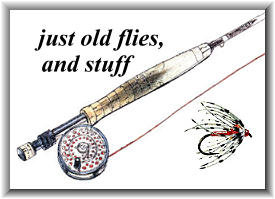The Parmachene series of flies owes it name to Parmachene Lake
in Maine and to an eastern brook trout fisherman, H.P. Wells.
Wells developed the Parmachene Belle in 1878 as an imitation
of a brook trout fin, a common bait used at that time. The fly
proved a good fish catcher and its use spread throughout North
America. When and who introduced it to British Columbia is
difficult to determine, but A. Bryan Williams, in Rod and
Creel in British Columbia (1919), highly recommends it
and says it "is used from one end of the Province to the other"
(page 42).
Sometime in the 1920s bucktails became the fly to use, and Colonel
Carey, of Carey Special fame, must have developed the Parmachene
bucktail pattern after bucktails became popular. In later years, after
1935, polar bear replaced bucktail in the wing, but that did not result
in a name change.
In the 1930s there was confusion among fishermen about Colonel
Carey's patterns and Rod Haig-Brown wrote Harkley & Haywood
about this. Haig-Brown was under the impression that the Parmachene
Bucktail was referred to by some as Carey's Special and that there
was another pattern called Col. Kerry's Special of which he enclosed
a sample for Mr. Haywood to verify.
The 12 July 1939 return letter from Haywood says:
Enclosed herewith please find the Col. Carey's special as known to
the Interior of B.C. people. The coast [fly fishers] have always called it
the Dredge, and incidentally that is the way it is used. The correct name
for the other one is Col. Carey's Parmachene Bucktail.
Colonel Carey's Parmachene Bucktail is little used today; however, it
provided many years service. Patrick attests to its popularity in
Pacific Northwest Fly Patterns, 1964 edition, when
he says that this fly "has been very good for both interior lake fishing
and migratory [trout fishing] on the coast.
The recipe is: Carey's Parmachene Bucktail
Hook: Number 6 and 8.
Tail: Red Swan.
Body: Yellow silk.
Rib: Oval, silver tinsel.
Throat: Grizzly.
Wing: White bucktail with strips of orange swan along side.
~ Arthur James Lingren
Credits: From Fly Patterns of British Columbia
by Arthur James Lingren. We thank
Frank Amato Publications, Inc. for use permission!
|



